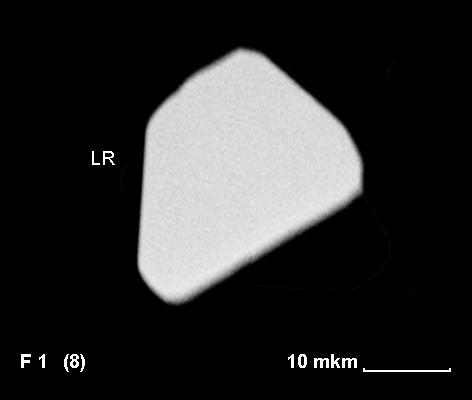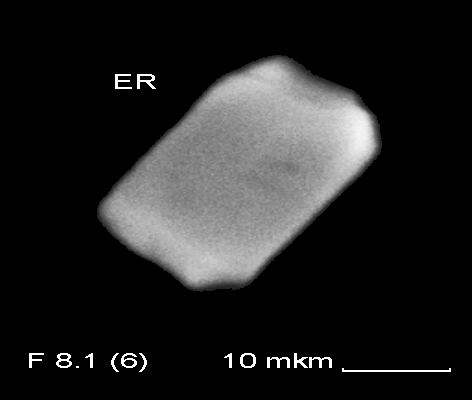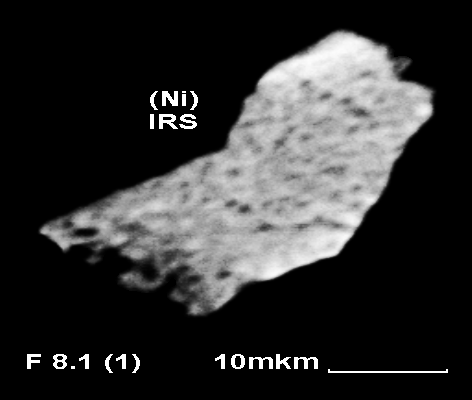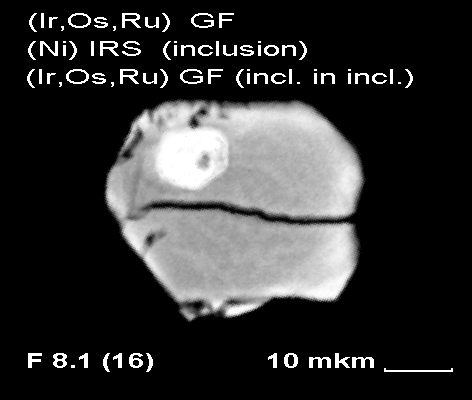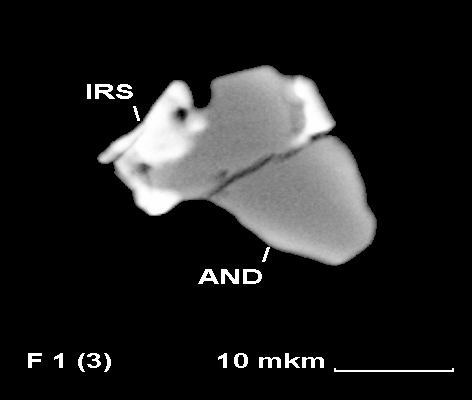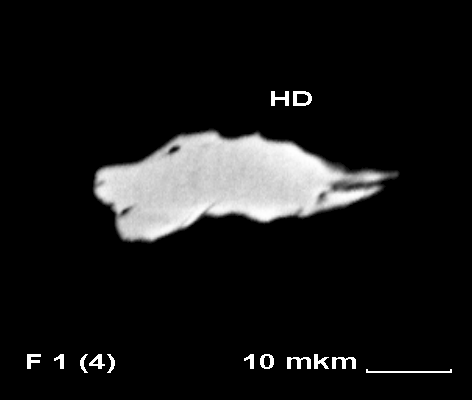PGMs in Outokumpu Ophiolites (Finland)
Introduction
The dominant part of this investigation was to reveal the phase forms of platinum group elements (PGE) in ultramafic part of Outokumpu ophiolite complex widespread in the eastern of Finland.
Samples for investigations were obtained from three serpentinite bodies located in 5 – 15km to the north and to the east from the Outokumpu town. The samples (about 500g) are presented predominantly by serpentine, partially by talc and impregnated chromite and rare fine grains of sulphide minerals. One sample contain single grains of chromite and about 10% ilmenite. It is not possible to reconstruct the primary rock exactly because of the major primary minerals was replaced by serpentine and talc and primary rock structures was lost by aftermagmatic processes.
Mineralogical analysis by technology “ppm-mineralogy “was carried out for fractions < 44µm of samples with weight 30–60g. In heavy concentrates of samples were revealed the following minerals: chromite, ilmenite, pentlandite, nickeline, pyrite, gersdorffite, Co-gersdorffite, galenite, hedleyite, baddeleyite, native iron, tin, lead, cupper and also unknown Ni-Bi phases. As well were revealed well-known PGE minerals: erlichmanite, laurite, irarsite, osarsite, sperrylite, anduoite and also not mentioned in the reference mineralogical literature before - gersdorffite and Co-gersdorffite, containing Os, Ir, Ru and Rh in quantities - up to 15 mass % (Ru up to 1.7, Os up to 9.3, Ir up to 3.2, Rh up to 0.5).
Even at a sketchy analysis of enlisted minerals the attention is brought to the fact that the list contains minerals atypical for ultramafic sulphides: one's more common for metamorphic, metasomatic and hydrothermal rocks. Moreover, from the minerals enlisted above only pentlandite is typical and only for ultramafic complexes with copper-nickel specialization. From enlisted PGE minerals: laurite (RuS2), erlichmanite (OsS2) and sperrylite (PtAs2) - are usual for Alpine-type ultramafic complexes. Sulphurasenides of osmium and iridium ( irarsite, osarsite) and especially unusual phases (Os, Ir, Ru, Rh)-gersdorrfite were not described in a structure of chromitite deposits. Anduoite is a rear mineral, therefore it is difficult to speak about its paragenesises. However, we shall mark, that replacement of anduoite by irarsite allows us to suppose that anduoite is synchronous to laurite, erlichmanite and sperrylite and, consequently, to formation of ultramafic complex itself.
|
Minerals. Back Scattered Electron Microscope Images
Clicking on images provides the higher resolution ones
|
||||
|
1
|
Euhedral grain of laurite (LR): (Ru, Os, Ir)S2.
|
2
|
Euhedral grain of erlichmanite (ER): (Os,Ru,Ir)S2.
|
|
|
3
|
Euhedral grain of sperrylite (SP): PtAs2. In examined samples is rare: only single grains are revealed.
|
4
|
Euhedral unitized grain of laurite-erlichmanite (LR,ER) replaced by Ni-LR and nickel-irarsite (Ni-IRS): (Ir,Ru,Rh,Ni)AsS.
|
|
|
5
|
Pseudomorph of nickel-irarsite (Ni-IRS). Euhedral primary grain of laurite (LR) distinctly visible.
|
6
|
Xenomorphic grain of laurite-erlichmanite (LR-ER) with a zone enriched by NI-(LR-ER), which one without distinct phase boundary passes into nickel-irarsite (Ni-IRS). (Full Image view is recommended)
|
|
|
7
|
Cellular xenomorphic grain of nickel-irarsite (Ni-IRS) heterogeneous by chemical composition.
|
8
|
Irarsite of concretionary structure (Ni-IRS) contained in (Os,Ir,Ru) gersdorffite (GF): NiAsS. In irarsite is well defined hexagonal nucleus surrounded by radial and concentric zones of irarsite with variable contents of Os, Ir, Ru, Rh and Ni. (Full Image view is recommended)
|
|
|
9
|
Inclusion of skeletal (?) crystal of irarsite(IRS) in gersdorffite(GF). Hexagonal nucleus is seen in the center of irarsite crystal. (Full Image view recommended).
|
10
|
Inclusion of irarsite (IRS) in unitized crystal of gersdorffite(GF). 1 – units of GF enriched by As, 2 – units of GF enriched by S.
|
|
|
11
|
Laminated dendrite (?) of irarsite(IRS) developing along a surface of laurite(LR). (Full Image view is recommended)
|
12
|
A grain of laurite (LR) with irarsite growth (fine long crystal adjoining at the left and above to LR) contained in (Ir,Os) gersdorffite(GF). (Full Image view is recommended)
|
|
|
13
|
Inclusion of irarsite (IRS) in euhedral crystal of gersdorffite(GF). In a Full Image view mode - more bright and more dark zones resulted from variations of relation As/S are visible in gersdorffite.
|
14
|
Fine inclusion of gersdorffite (a dark spot in bright phase) in inclusion of irarsite (bright phase) in gersdorffite.
|
|
|
15
|
Irarsite (IRS) replacing anduoite(AND): (Ru,Os)As2.
|
16
|
Unknown phases of NiBi with various relations of Ni/Bi.
|
|
|
17
|
Hedleyite(HD): Bi7Te3. A representative mineral of Au paragenesis of Finland and Karelia in gold deposits, formed by Svecofennian metamorphic-metasomatic processes.
|
18
|
Intergrowths of native tin (Sn) and lead (Pb).
|
|
Discussion
The derived data allow to make the following conclusions:
- Among the PGE minerals we can distinguish three groups by shape of crystals, chemical composition and character of relationship between minerals. Each of them represents different processes of formation and transformation the ultramafiic part of ophiolites Outokumpu region:
1- euhedral grains of laurite, erlichmanite and sperrylite (photo 1-3). These minerals are typical for Alpine-type ultramafic complexes. Their formation is synchronous to formation of rock matrix (i.e. crystallization minerals irrespective of when and in what conditions was going on the formation of ultramafic complexes). Presumptively it is possible to assign anduoite to this group (photo 15);
2- a group including: a)- relicts of euhedral grains of laurite–erlichmanite with zones of laurite variation (Ni-laurite) and irarsite replacing by Ni-laurite (photo 4), and also pseudomorphes of irarsite by laurite (photo 5), and dendrites of irarsite in laurite (photo 11); b)- xenomorphic relict grains of laurite replaced by irarsite (photo 6 and partly – irarsite-laurite “nucleus” on photo 12) and also xenomorphic cellular grains of irarsite probably formed as a result of complete replacement of laurite (photo 7).
Replacement the PGE-minerals of crystallization stage of ultramafic complex formation by sulphurarsenides, which contain the same chemical elements as replaced minerals, - is the evidence of an aftercrystallization thermal rock transforming process. PGE minerals was involved to redistribution also, according to conditions of this process;
3 - “Direct” and “reverse” inclusions and intergrowthes of irarsite grains with (Os,Ir,Ru,Rh)-gersdorffite (photo 8-14). It is seen from photograph 8 that irarsite of concretionary structure (concretion – structure of growth !) is included in gersdorffite and is the earlier formation. This follows from photo 12 and 13 as well. However, from photo 14 it is seen that a fine grain of gersdorffite is included in irarsite and the last one is included in gersdorffite! These data demonstrate that at least some part of gersdorffite phase is synchronous to formation of irarsite. And the process of transformation of primary crystallization PGE minerals (laurite, erlichmanite, sperrylite) results in formation of both irarsite and gersdorffite. This conclusion is confirmed by the fact that Os, Ir, Ru Rh in variable (but considerable) quantities enter into the composition of gersdorffite. It means that in the process of transformation of crystallization PGE minerals in crystallization medium for a rather long time were present Ni (is revealed both in changed zones of laurite and in irarsite), Os,Ir,Ru,Rh. These elements at first entered into the composition of irarsite and then into composition of gersdorffite (the minerals have the similar crystalline texture and both are assigned to the group of cobaltite) with change of conditions of crystallization and spending of these elements (uniting them in minerals). As, S and Ni overcount PGE in quantity, therefore not all gersdorffites revealed in samples carry on PGE on their composition.
- The revealed process of transformation of PGE minerals in ultramafic part of ophiolites is a component of more extended regional process of transformation the whole Outokumpu ophiolite complex. Despite of distinctions in original composition of investigated rocks the characteristic features of this process are observed in all rocks (samples) with a greater or lesser extent. Moreover, samples were collected from isolated serpentinite bodies placed more than 10km apart. It is possible to suppose that this process is synchronous to one of the stages of formation Svecofennian structure at the region. Possible, this thermal process is the regional metamorphism with related redistribution chemical composition of rocks (including ultramafic). More precise age dating is possible if it will be determined the Os isotopes using different PGE minerals or Pb/U relation by uraninites occasionally occur in heavy concentrates of samples.
-- From investigations given above follow that at the transformation of ultramafic complex take place redistribution of the PGE with its concentration in different phases of sulphurarsenides which are the phases–bearing noble metals. Since sulphurarsenides are of hydrothermal metamorphic-metasomatic (aftercrystallizational in relation to ultramafic rocks) genesis, their spatial localization as ore bodies also may be firstly, - occur outrange from serpentinite bodies and secondly, - occur as conform or cross-cutting veins and metasomatites.
Such genetic type of noble metal mineralization is not studied enough, but it does not mean that it may not have a commercial importance. Our evaluation for sample F8.1 shows that total concentration of Os, Ir, Ru, Rh, Pt converted to weight of sample makes up not less than 0.5ppm. Determination of maximum concentrations of PGE and their reserves within the limits of bodies of hydrothermal genesis calls for additional investigations. It is especially important because the process of redistribution and concentration of PGE minerals has a regional scale. Revealing of noble metal mineralization of hydrothermal genesis may be very promising within the boundaries of the whole ophiolite complex.

